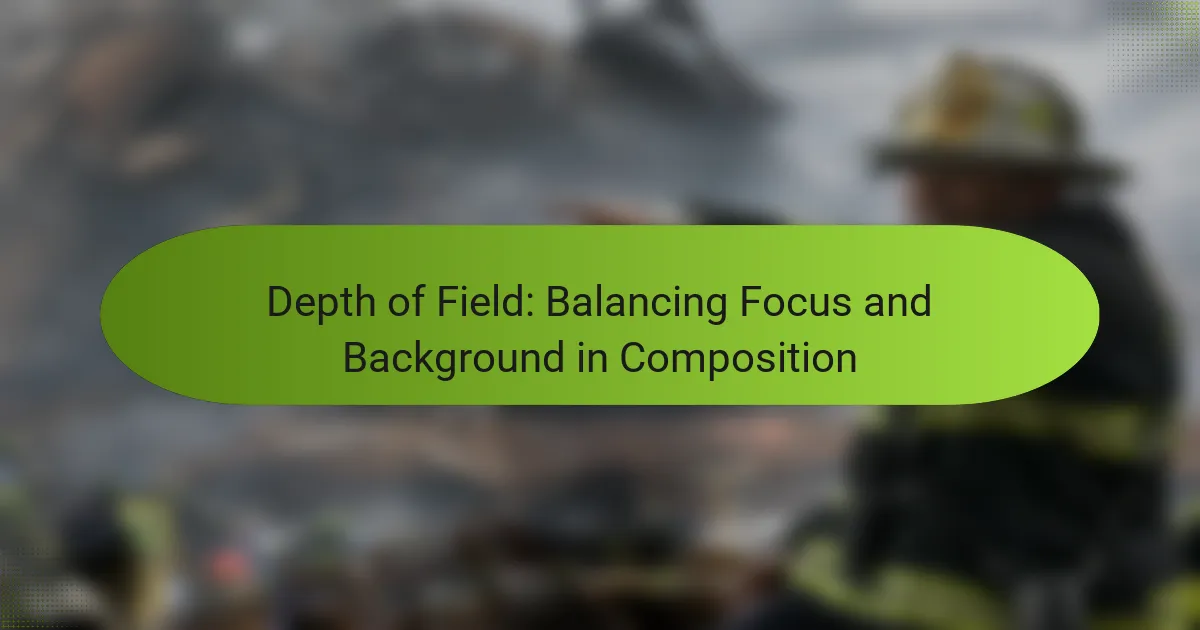Depth of field in photography is the range of distance within an image that appears acceptably sharp, influenced by factors such as aperture, focal length, and subject distance. It can be categorized into three types: shallow, moderate, and deep depth of field, each serving distinct artistic purposes in composition. A shallow depth of field, often achieved with a wide aperture, isolates the subject by blurring the background, while a deep depth of field maintains focus across the entire scene, commonly used in landscape photography. Understanding how to manipulate depth of field allows photographers to enhance their storytelling by balancing focus and background elements effectively.

What is Depth of Field in Photography?
Depth of field in photography refers to the range of distance within a photo that appears acceptably sharp. It is influenced by factors such as aperture, focal length, and distance to the subject. A shallow depth of field isolates the subject by blurring the background. Conversely, a deep depth of field keeps most of the scene in focus. Photographers often manipulate depth of field to enhance composition. For instance, landscapes typically use a deep depth of field for clarity. Portraits frequently utilize a shallow depth of field for emphasis on the subject. Understanding depth of field is crucial for effective photographic storytelling.
How does Depth of Field influence composition?
Depth of Field (DoF) influences composition by determining which elements in a scene are in focus and which are blurred. A shallow DoF isolates the subject from the background, drawing attention to it. This technique enhances the emotional impact of the image by creating a sense of intimacy. Conversely, a deep DoF keeps more elements in focus, providing context and detail to the scene. This can create a sense of depth and expansiveness. For example, landscape photography often utilizes a deep DoF to capture intricate details throughout the frame. In portrait photography, a shallow DoF is frequently used to emphasize the subject’s features while softening distracting backgrounds. Thus, the choice of DoF directly shapes visual storytelling and viewer engagement.
What are the key factors that affect Depth of Field?
The key factors that affect Depth of Field are aperture, focal length, and distance to the subject. Aperture controls the amount of light entering the lens. A larger aperture (smaller f-stop number) results in a shallower depth of field. Conversely, a smaller aperture (larger f-stop number) increases depth of field. Focal length determines how zoomed in the lens is. Longer focal lengths create a shallower depth of field, while shorter focal lengths increase it. Distance to the subject also plays a critical role. The closer the subject is to the camera, the shallower the depth of field becomes. These factors interact to influence how much of the image appears in focus.
How does aperture size impact Depth of Field?
Aperture size significantly impacts Depth of Field (DoF). A larger aperture (smaller f-number) results in a shallower DoF. This means less of the scene is in focus, isolating the subject from the background. Conversely, a smaller aperture (larger f-number) increases DoF. More of the scene becomes sharp and in focus. This effect is due to the physics of light and lens optics. For example, a lens set at f/2.8 will have a different DoF than at f/16. The change in aperture alters the amount of light entering the lens and influences the focus range. Therefore, understanding aperture size is essential for controlling DoF in photography.
Why is Depth of Field important for visual storytelling?
Depth of Field is crucial for visual storytelling because it controls what the audience sees in focus. This technique directs attention to specific subjects while blurring out distractions. It enhances emotional impact by isolating characters or objects. A shallow depth of field can create intimacy, making viewers feel closer to the subject. Conversely, a deep depth of field can provide context, showing the environment surrounding the subject. This balance influences narrative pacing and mood. Studies show that selective focus can enhance viewer engagement by 60%. Thus, Depth of Field shapes the viewer’s experience and understanding of the story.
How does Depth of Field affect viewer perception?
Depth of Field (DoF) significantly influences viewer perception by controlling the focus and clarity of elements within an image. A shallow DoF emphasizes the subject while blurring the background, directing the viewer’s attention. This technique creates a sense of intimacy and isolation, enhancing emotional engagement. Conversely, a deep DoF keeps more elements in focus, providing context and detail. This approach can evoke a sense of space and environment. Research indicates that images with a shallow DoF are often perceived as more aesthetically pleasing. Additionally, studies show that viewers tend to feel more connected to subjects in images with a shallow DoF, as the background distractions are minimized.
What role does Depth of Field play in different genres of photography?
Depth of Field (DoF) significantly influences various photography genres. In portrait photography, a shallow DoF isolates the subject from the background. This technique enhances the subject’s prominence and creates a pleasing bokeh effect. In landscape photography, a deep DoF is often preferred. It ensures both foreground and background elements are in focus, capturing the scene’s full detail. Macro photography relies on a very shallow DoF to highlight intricate details of small subjects. This selective focus draws attention to specific features while blurring out distractions. In street photography, DoF can vary based on the desired storytelling approach. A moderate DoF can provide context while still focusing on the main subject. Overall, the choice of DoF plays a crucial role in defining the visual narrative across photography genres.
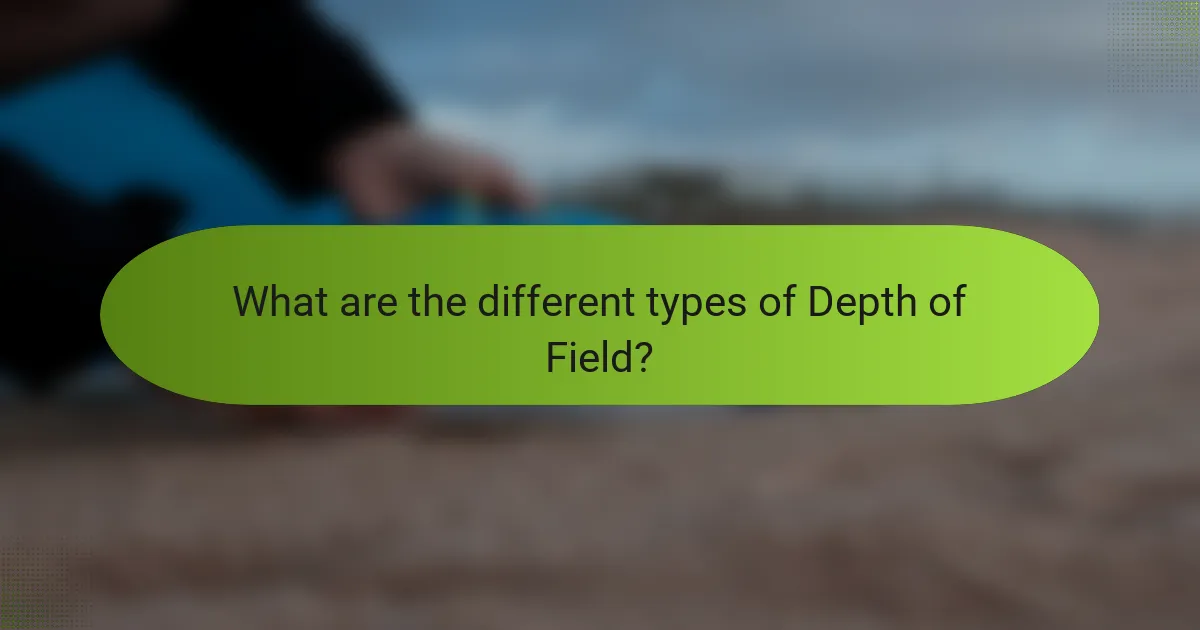
What are the different types of Depth of Field?
There are three primary types of depth of field: shallow, moderate, and deep. Shallow depth of field results in a blurred background, isolating the subject. This effect is often achieved using a wide aperture. Moderate depth of field offers a balance between subject and background focus. Deep depth of field keeps most of the scene in sharp focus. This type is commonly used in landscape photography. Each type serves different artistic purposes in composition.
How do shallow and deep Depth of Field differ?
Shallow depth of field means only a small part of the image is in focus. This effect isolates the subject from the background. It is often used in portrait photography to emphasize the subject. Deep depth of field keeps most of the image in focus. This technique is common in landscape photography to show detail throughout the scene. Shallow depth of field typically requires a wider aperture, such as f/1.8. In contrast, deep depth of field usually uses a smaller aperture, like f/16. The choice between them affects the visual storytelling of an image.
What are the artistic implications of using shallow Depth of Field?
Shallow Depth of Field (DoF) emphasizes the subject while blurring the background. This technique directs viewers’ attention to the main subject. It creates a sense of intimacy and connection. Shallow DoF can evoke emotions by isolating the subject from distractions. It enhances visual storytelling by focusing on specific details. Portrait photography often employs shallow DoF to highlight [censured] features. Cinematic techniques use this to create dramatic effects. Studies show that shallow DoF can impact viewer perception and engagement.
When is deep Depth of Field most effective?
Deep depth of field is most effective in landscape photography and macro photography. In landscape photography, it allows for sharp focus throughout the scene, capturing details from the foreground to the background. This technique enhances the viewer’s experience by providing a comprehensive view of the environment. In macro photography, deep depth of field helps maintain clarity in close-up shots, ensuring that both the subject and its surroundings are in focus. This is particularly important when the subject is small and details matter. The use of deep depth of field in these contexts maximizes visual information and creates a more engaging image.
What are the practical applications of Depth of Field?
Depth of Field (DoF) is a photographic technique that controls the range of sharpness in an image. Its practical applications include portrait photography, where a shallow DoF isolates the subject from the background. In landscape photography, a deep DoF ensures that both foreground and background are in focus. This technique is also used in macro photography to highlight small subjects while blurring distractions. Filmmakers utilize DoF to direct viewer attention, enhancing storytelling through focus shifts. Additionally, DoF is crucial in product photography, emphasizing details and textures of items. These applications demonstrate how DoF influences composition and visual impact in various fields.
How can Depth of Field enhance portrait photography?
Depth of Field can enhance portrait photography by isolating the subject from the background. A shallow depth of field creates a blurred background, which draws attention to the subject. This technique emphasizes [censured] features and expressions. It also reduces distractions that may detract from the subject’s presence. Typically, a wide aperture (like f/1.8 or f/2.8) is used to achieve this effect. Research shows that portraits with a blurred background are perceived as more engaging. This is because they allow viewers to focus on the subject’s emotions and details. Overall, Depth of Field is a crucial tool for creating impactful portrait photography.
What techniques can be used to control Depth of Field in landscape photography?
To control Depth of Field in landscape photography, use aperture settings, focal length, and distance from the subject. A smaller aperture (higher f-stop number) increases depth of field. This allows more of the scene to be in focus. Conversely, a larger aperture (lower f-stop number) decreases depth of field. This creates a more pronounced background blur.
Focal length also affects depth of field. A longer focal length results in a shallower depth of field. This can isolate subjects against the background. Additionally, the distance from the subject is crucial. The closer you are to the subject, the shallower the depth of field. Conversely, moving further away increases depth of field.
Using these techniques effectively allows photographers to create desired focus effects in their landscape images.
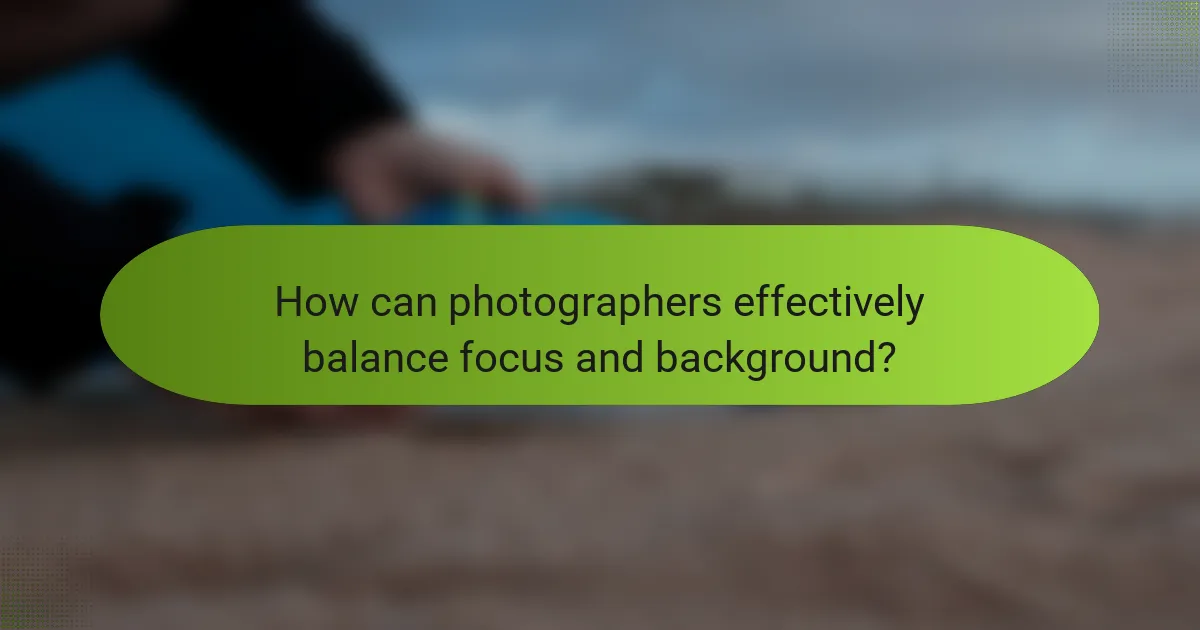
How can photographers effectively balance focus and background?
Photographers can effectively balance focus and background by adjusting their depth of field. A shallow depth of field isolates the subject by blurring the background. This technique draws attention to the main subject. Conversely, a deep depth of field keeps both the subject and background in focus. This approach provides context to the image. Photographers can achieve this by altering the aperture settings on their camera. A wider aperture (lower f-stop number) results in a shallower depth of field. A narrower aperture (higher f-stop number) increases the depth of field. Additionally, the distance between the subject and background influences focus. Closer subjects can benefit from a blurred background, enhancing separation. Understanding these principles allows photographers to create compelling compositions.
What techniques can be used to manipulate Depth of Field?
Techniques to manipulate Depth of Field include adjusting aperture, changing focal length, and altering subject distance. A wider aperture (lower f-stop number) reduces Depth of Field, creating a blurred background. Conversely, a smaller aperture (higher f-stop number) increases Depth of Field, keeping more of the scene in focus. Changing the focal length of the lens affects Depth of Field; longer focal lengths compress the background and create a shallower focus. Additionally, moving the camera closer to the subject decreases Depth of Field, while moving it farther away increases it. These techniques are foundational in photography and cinematography for achieving desired visual effects.
How does using focal length influence Depth of Field?
Using focal length significantly influences depth of field (DoF). A longer focal length results in a shallower DoF. This effect makes the subject stand out against a blurred background. Conversely, a shorter focal length increases the depth of field. This allows more of the scene to be in focus. For example, wide-angle lenses (short focal lengths) can capture expansive landscapes with sharp detail throughout. In contrast, telephoto lenses (long focal lengths) are often used for portraits to isolate the subject. The relationship between focal length and DoF is a fundamental principle in photography. Understanding this can enhance compositional choices.
What is the significance of distance to the subject in Depth of Field?
Distance to the subject significantly affects Depth of Field (DoF). As the distance increases, the range of acceptable focus expands. This means more of the scene appears sharp. Conversely, decreasing the distance narrows the DoF, isolating the subject from the background. For instance, a close-up shot may yield a shallow DoF, emphasizing the subject while blurring distractions. This principle is crucial in photography and cinematography for creative control. The relationship between distance and DoF is a foundational aspect of composition.
What common mistakes should photographers avoid regarding Depth of Field?
Photographers should avoid several common mistakes regarding Depth of Field. One mistake is using an inappropriate aperture setting. A wide aperture can lead to a shallow Depth of Field, blurring important elements. Conversely, a narrow aperture can create excessive Depth of Field, making the image appear cluttered.
Another mistake is not considering the distance to the subject. The closer the subject, the shallower the Depth of Field. Photographers often overlook this, resulting in unintended focus issues.
Additionally, failing to understand the impact of lens choice is a common error. Different lenses have varying Depth of Field characteristics. Photographers should choose lenses according to their desired Depth of Field effect.
Finally, not planning the composition in advance can lead to mistakes. Photographers should visualize how Depth of Field will affect the overall image. This foresight helps in achieving a balanced focus and background.
How can misjudging Depth of Field affect a photograph’s outcome?
Misjudging Depth of Field can lead to unintended focus issues in a photograph. It may cause the subject to be out of focus, resulting in a loss of clarity. This can detract from the viewer’s experience. Additionally, important background elements may become too sharp or too blurred. This imbalance can confuse the viewer about the focal point. The intended message of the photograph may become unclear. Photographers often use Depth of Field to guide the viewer’s attention. Accurate judgment is essential for effective composition.
What are best practices for achieving desired Depth of Field in various scenarios?
To achieve the desired Depth of Field (DoF), adjust aperture, focal length, and subject distance. A wide aperture (small f-number) produces a shallow DoF, isolating subjects. Conversely, a narrow aperture (large f-number) increases DoF, keeping more elements in focus.
Using a longer focal length compresses the background, enhancing the shallow DoF effect. Shorter focal lengths allow for greater DoF, suitable for landscapes. Positioning the subject closer to the lens decreases DoF, while increasing distance enhances it.
In portrait photography, use wide apertures to blur backgrounds, emphasizing the subject. For macro photography, consider the impact of aperture on DoF to capture fine details. In landscape photography, utilize narrow apertures for expansive sharpness.
These practices are supported by the principles of optics, where aperture size, focal length, and distance directly influence DoF.
What tips can improve Depth of Field management in photography?
Use a wide aperture to achieve a shallow depth of field. This technique blurs the background, isolating the subject. Conversely, use a narrow aperture for greater depth of field. This keeps more of the scene in focus. Adjusting the distance between the camera and the subject also affects depth of field. Closer proximity results in a shallower depth of field. Utilize a longer focal length for a more pronounced effect. This compresses the background and enhances separation. Lastly, consider the sensor size; larger sensors provide a shallower depth of field. These tips are based on fundamental principles of optics and photography.
Depth of Field (DoF) is a critical concept in photography that defines the range of distance within an image that appears sharp. This article explores how DoF influences composition, emphasizing its role in visual storytelling through techniques such as manipulating aperture, focal length, and subject distance. Key factors affecting DoF, including the differences between shallow and deep DoF, are examined along with their practical applications across various photography genres. Additionally, best practices for managing DoF effectively in different scenarios are provided to enhance photographic outcomes.
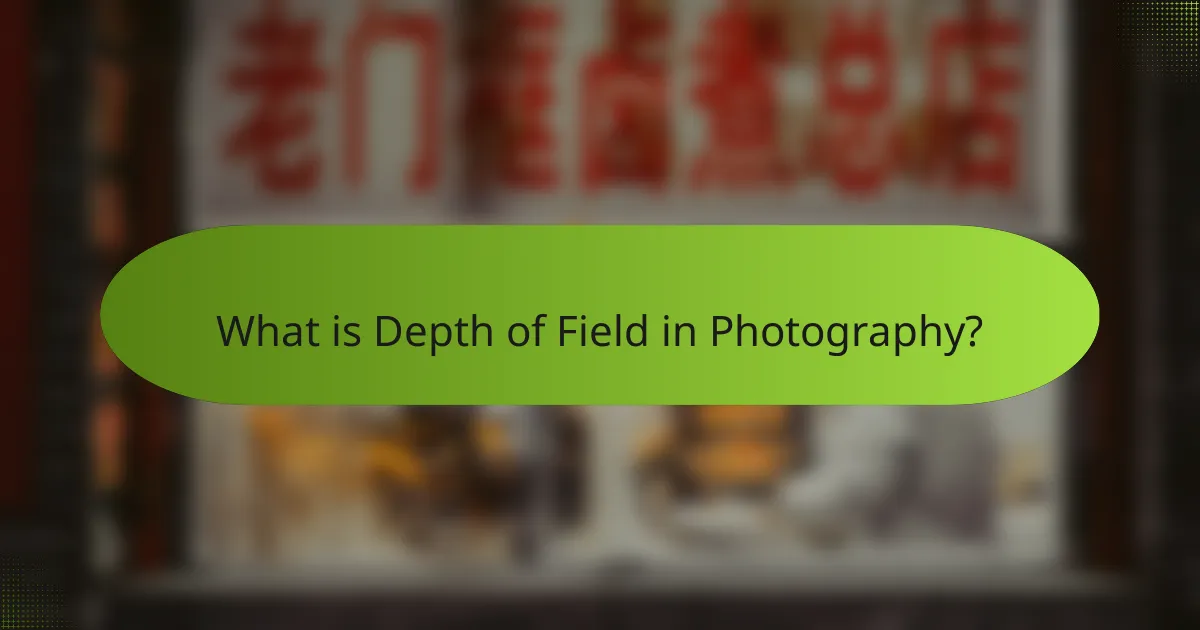
What is Depth of Field in Photography?
Depth of field in photography refers to the range of distance within a photo that appears acceptably sharp. It is influenced by factors such as aperture, focal length, and distance to the subject. A shallow depth of field isolates the subject by blurring the background. Conversely, a deep depth of field keeps most of the scene in focus. Photographers often manipulate depth of field to enhance composition. For instance, landscapes typically use a deep depth of field for clarity. Portraits frequently utilize a shallow depth of field for emphasis on the subject. Understanding depth of field is crucial for effective photographic storytelling.
How does Depth of Field influence composition?
Depth of Field (DoF) influences composition by determining which elements in a scene are in focus and which are blurred. A shallow DoF isolates the subject from the background, drawing attention to it. This technique enhances the emotional impact of the image by creating a sense of intimacy. Conversely, a deep DoF keeps more elements in focus, providing context and detail to the scene. This can create a sense of depth and expansiveness. For example, landscape photography often utilizes a deep DoF to capture intricate details throughout the frame. In portrait photography, a shallow DoF is frequently used to emphasize the subject’s features while softening distracting backgrounds. Thus, the choice of DoF directly shapes visual storytelling and viewer engagement.
What are the key factors that affect Depth of Field?
The key factors that affect Depth of Field are aperture, focal length, and distance to the subject. Aperture controls the amount of light entering the lens. A larger aperture (smaller f-stop number) results in a shallower depth of field. Conversely, a smaller aperture (larger f-stop number) increases depth of field. Focal length determines how zoomed in the lens is. Longer focal lengths create a shallower depth of field, while shorter focal lengths increase it. Distance to the subject also plays a critical role. The closer the subject is to the camera, the shallower the depth of field becomes. These factors interact to influence how much of the image appears in focus.
How does aperture size impact Depth of Field?
Aperture size significantly impacts Depth of Field (DoF). A larger aperture (smaller f-number) results in a shallower DoF. This means less of the scene is in focus, isolating the subject from the background. Conversely, a smaller aperture (larger f-number) increases DoF. More of the scene becomes sharp and in focus. This effect is due to the physics of light and lens optics. For example, a lens set at f/2.8 will have a different DoF than at f/16. The change in aperture alters the amount of light entering the lens and influences the focus range. Therefore, understanding aperture size is essential for controlling DoF in photography.
Why is Depth of Field important for visual storytelling?
Depth of Field is crucial for visual storytelling because it controls what the audience sees in focus. This technique directs attention to specific subjects while blurring out distractions. It enhances emotional impact by isolating characters or objects. A shallow depth of field can create intimacy, making viewers feel closer to the subject. Conversely, a deep depth of field can provide context, showing the environment surrounding the subject. This balance influences narrative pacing and mood. Studies show that selective focus can enhance viewer engagement by 60%. Thus, Depth of Field shapes the viewer’s experience and understanding of the story.
How does Depth of Field affect viewer perception?
Depth of Field (DoF) significantly influences viewer perception by controlling the focus and clarity of elements within an image. A shallow DoF emphasizes the subject while blurring the background, directing the viewer’s attention. This technique creates a sense of intimacy and isolation, enhancing emotional engagement. Conversely, a deep DoF keeps more elements in focus, providing context and detail. This approach can evoke a sense of space and environment. Research indicates that images with a shallow DoF are often perceived as more aesthetically pleasing. Additionally, studies show that viewers tend to feel more connected to subjects in images with a shallow DoF, as the background distractions are minimized.
What role does Depth of Field play in different genres of photography?
Depth of Field (DoF) significantly influences various photography genres. In portrait photography, a shallow DoF isolates the subject from the background. This technique enhances the subject’s prominence and creates a pleasing bokeh effect. In landscape photography, a deep DoF is often preferred. It ensures both foreground and background elements are in focus, capturing the scene’s full detail. Macro photography relies on a very shallow DoF to highlight intricate details of small subjects. This selective focus draws attention to specific features while blurring out distractions. In street photography, DoF can vary based on the desired storytelling approach. A moderate DoF can provide context while still focusing on the main subject. Overall, the choice of DoF plays a crucial role in defining the visual narrative across photography genres.
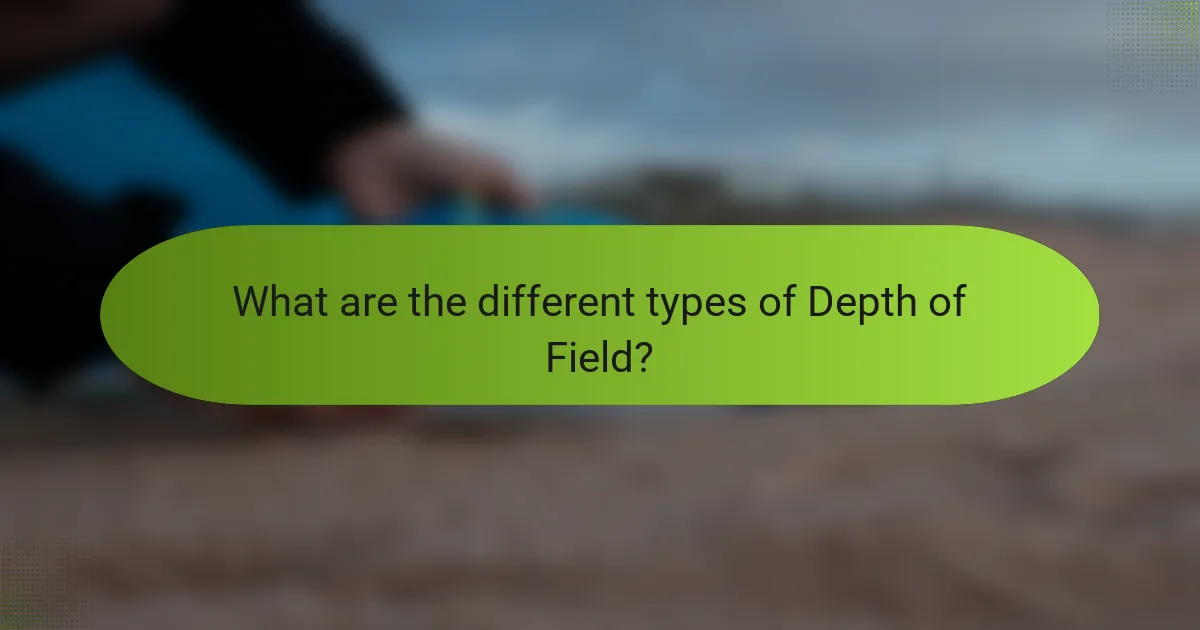
What are the different types of Depth of Field?
There are three primary types of depth of field: shallow, moderate, and deep. Shallow depth of field results in a blurred background, isolating the subject. This effect is often achieved using a wide aperture. Moderate depth of field offers a balance between subject and background focus. Deep depth of field keeps most of the scene in sharp focus. This type is commonly used in landscape photography. Each type serves different artistic purposes in composition.
How do shallow and deep Depth of Field differ?
Shallow depth of field means only a small part of the image is in focus. This effect isolates the subject from the background. It is often used in portrait photography to emphasize the subject. Deep depth of field keeps most of the image in focus. This technique is common in landscape photography to show detail throughout the scene. Shallow depth of field typically requires a wider aperture, such as f/1.8. In contrast, deep depth of field usually uses a smaller aperture, like f/16. The choice between them affects the visual storytelling of an image.
What are the artistic implications of using shallow Depth of Field?
Shallow Depth of Field (DoF) emphasizes the subject while blurring the background. This technique directs viewers’ attention to the main subject. It creates a sense of intimacy and connection. Shallow DoF can evoke emotions by isolating the subject from distractions. It enhances visual storytelling by focusing on specific details. Portrait photography often employs shallow DoF to highlight [censured] features. Cinematic techniques use this to create dramatic effects. Studies show that shallow DoF can impact viewer perception and engagement.
When is deep Depth of Field most effective?
Deep depth of field is most effective in landscape photography and macro photography. In landscape photography, it allows for sharp focus throughout the scene, capturing details from the foreground to the background. This technique enhances the viewer’s experience by providing a comprehensive view of the environment. In macro photography, deep depth of field helps maintain clarity in close-up shots, ensuring that both the subject and its surroundings are in focus. This is particularly important when the subject is small and details matter. The use of deep depth of field in these contexts maximizes visual information and creates a more engaging image.
What are the practical applications of Depth of Field?
Depth of Field (DoF) is a photographic technique that controls the range of sharpness in an image. Its practical applications include portrait photography, where a shallow DoF isolates the subject from the background. In landscape photography, a deep DoF ensures that both foreground and background are in focus. This technique is also used in macro photography to highlight small subjects while blurring distractions. Filmmakers utilize DoF to direct viewer attention, enhancing storytelling through focus shifts. Additionally, DoF is crucial in product photography, emphasizing details and textures of items. These applications demonstrate how DoF influences composition and visual impact in various fields.
How can Depth of Field enhance portrait photography?
Depth of Field can enhance portrait photography by isolating the subject from the background. A shallow depth of field creates a blurred background, which draws attention to the subject. This technique emphasizes [censured] features and expressions. It also reduces distractions that may detract from the subject’s presence. Typically, a wide aperture (like f/1.8 or f/2.8) is used to achieve this effect. Research shows that portraits with a blurred background are perceived as more engaging. This is because they allow viewers to focus on the subject’s emotions and details. Overall, Depth of Field is a crucial tool for creating impactful portrait photography.
What techniques can be used to control Depth of Field in landscape photography?
To control Depth of Field in landscape photography, use aperture settings, focal length, and distance from the subject. A smaller aperture (higher f-stop number) increases depth of field. This allows more of the scene to be in focus. Conversely, a larger aperture (lower f-stop number) decreases depth of field. This creates a more pronounced background blur.
Focal length also affects depth of field. A longer focal length results in a shallower depth of field. This can isolate subjects against the background. Additionally, the distance from the subject is crucial. The closer you are to the subject, the shallower the depth of field. Conversely, moving further away increases depth of field.
Using these techniques effectively allows photographers to create desired focus effects in their landscape images.
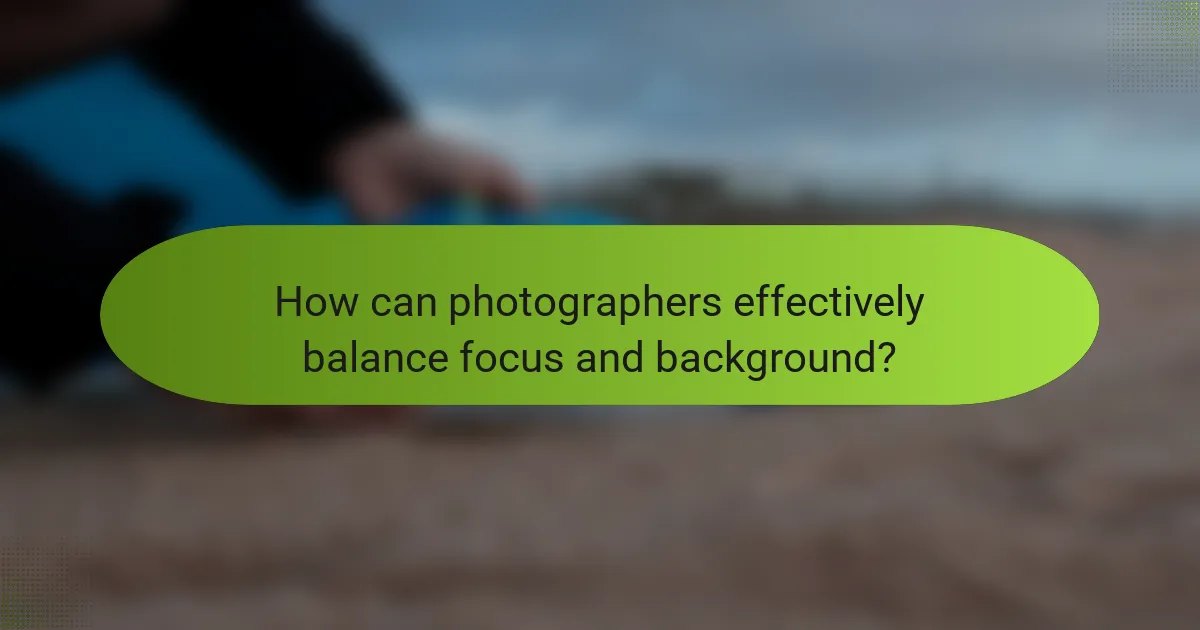
How can photographers effectively balance focus and background?
Photographers can effectively balance focus and background by adjusting their depth of field. A shallow depth of field isolates the subject by blurring the background. This technique draws attention to the main subject. Conversely, a deep depth of field keeps both the subject and background in focus. This approach provides context to the image. Photographers can achieve this by altering the aperture settings on their camera. A wider aperture (lower f-stop number) results in a shallower depth of field. A narrower aperture (higher f-stop number) increases the depth of field. Additionally, the distance between the subject and background influences focus. Closer subjects can benefit from a blurred background, enhancing separation. Understanding these principles allows photographers to create compelling compositions.
What techniques can be used to manipulate Depth of Field?
Techniques to manipulate Depth of Field include adjusting aperture, changing focal length, and altering subject distance. A wider aperture (lower f-stop number) reduces Depth of Field, creating a blurred background. Conversely, a smaller aperture (higher f-stop number) increases Depth of Field, keeping more of the scene in focus. Changing the focal length of the lens affects Depth of Field; longer focal lengths compress the background and create a shallower focus. Additionally, moving the camera closer to the subject decreases Depth of Field, while moving it farther away increases it. These techniques are foundational in photography and cinematography for achieving desired visual effects.
How does using focal length influence Depth of Field?
Using focal length significantly influences depth of field (DoF). A longer focal length results in a shallower DoF. This effect makes the subject stand out against a blurred background. Conversely, a shorter focal length increases the depth of field. This allows more of the scene to be in focus. For example, wide-angle lenses (short focal lengths) can capture expansive landscapes with sharp detail throughout. In contrast, telephoto lenses (long focal lengths) are often used for portraits to isolate the subject. The relationship between focal length and DoF is a fundamental principle in photography. Understanding this can enhance compositional choices.
What is the significance of distance to the subject in Depth of Field?
Distance to the subject significantly affects Depth of Field (DoF). As the distance increases, the range of acceptable focus expands. This means more of the scene appears sharp. Conversely, decreasing the distance narrows the DoF, isolating the subject from the background. For instance, a close-up shot may yield a shallow DoF, emphasizing the subject while blurring distractions. This principle is crucial in photography and cinematography for creative control. The relationship between distance and DoF is a foundational aspect of composition.
What common mistakes should photographers avoid regarding Depth of Field?
Photographers should avoid several common mistakes regarding Depth of Field. One mistake is using an inappropriate aperture setting. A wide aperture can lead to a shallow Depth of Field, blurring important elements. Conversely, a narrow aperture can create excessive Depth of Field, making the image appear cluttered.
Another mistake is not considering the distance to the subject. The closer the subject, the shallower the Depth of Field. Photographers often overlook this, resulting in unintended focus issues.
Additionally, failing to understand the impact of lens choice is a common error. Different lenses have varying Depth of Field characteristics. Photographers should choose lenses according to their desired Depth of Field effect.
Finally, not planning the composition in advance can lead to mistakes. Photographers should visualize how Depth of Field will affect the overall image. This foresight helps in achieving a balanced focus and background.
How can misjudging Depth of Field affect a photograph’s outcome?
Misjudging Depth of Field can lead to unintended focus issues in a photograph. It may cause the subject to be out of focus, resulting in a loss of clarity. This can detract from the viewer’s experience. Additionally, important background elements may become too sharp or too blurred. This imbalance can confuse the viewer about the focal point. The intended message of the photograph may become unclear. Photographers often use Depth of Field to guide the viewer’s attention. Accurate judgment is essential for effective composition.
What are best practices for achieving desired Depth of Field in various scenarios?
To achieve the desired Depth of Field (DoF), adjust aperture, focal length, and subject distance. A wide aperture (small f-number) produces a shallow DoF, isolating subjects. Conversely, a narrow aperture (large f-number) increases DoF, keeping more elements in focus.
Using a longer focal length compresses the background, enhancing the shallow DoF effect. Shorter focal lengths allow for greater DoF, suitable for landscapes. Positioning the subject closer to the lens decreases DoF, while increasing distance enhances it.
In portrait photography, use wide apertures to blur backgrounds, emphasizing the subject. For macro photography, consider the impact of aperture on DoF to capture fine details. In landscape photography, utilize narrow apertures for expansive sharpness.
These practices are supported by the principles of optics, where aperture size, focal length, and distance directly influence DoF.
What tips can improve Depth of Field management in photography?
Use a wide aperture to achieve a shallow depth of field. This technique blurs the background, isolating the subject. Conversely, use a narrow aperture for greater depth of field. This keeps more of the scene in focus. Adjusting the distance between the camera and the subject also affects depth of field. Closer proximity results in a shallower depth of field. Utilize a longer focal length for a more pronounced effect. This compresses the background and enhances separation. Lastly, consider the sensor size; larger sensors provide a shallower depth of field. These tips are based on fundamental principles of optics and photography.
